Digital Media Winter Institute 2018
SMART Data Sprint: Interpreters of Platform Data
29 January – 2 February 2018
Universidade Nova de Lisboa | NOVA FCSH | iNOVA Media Lab
Project title: Visualising engagement on Zika epidemic: public health and social insights from platform data analysis.
Project leaders: Elaine T. Rabello (State University of Rio de Janeiro, Brazil) and Gustavo C. Matta (Oswaldo Cruz Foundation, Brazil)
Team members: Ana Rita Costa | Alice Teixeira | Cecília Barbosa | Giacomo Flaim, Janna Joceli Omena | Lorena Cano-Orón and Tarcízio Silva.
- Project pitch slides: Visualising Engagement on Zika Epidemic
- Final presentation: Zika – Insights about engagement from platform data analysis
»Introduction
»Research Questions
»Dataset Visual Protocol
»Methodology
»Mapping Groups and Pages related to Zika on Facebook
»Data Cleaning: Facebook Pages and Groups
»Facebook selected Pages and Groups
»Wikipedia: Zika edits and views overtime
»Google: Top ranked websites, key players and associated content
»Instagram: The dominant voice and the most active users by tag mention
»Facebook: Network, Visual and Textual Analysis of Pages and Groups related to Zika
»Facebook Pages
»Facebook Groups
Key Findings
—>As a source if information about Zika, Wikipedia is not as relevant to Portuguese speakers as it is to English speakers.
—> On Google, media and press websites are the most accessed as a source of information about Zika, although the access to government websites increased of importance during the last years. Industry and commerce have also been important voices on this platform.
—> On Instagram, there is an absence of Brazilian government entities within the group of the dominant voices; in general, they were not capable of producing influential visual content about Zika epidemic in Brazil.
—> On Facebook, besides the long list of Pages and Groups associated with Zika Epidemic, there is an absence of a Page Like Network community (which means Zika-related Pages scarcely connect to each other) . The visual content analysis points to two kinds of images being shared by Facebook Pages between June 2016 and January 2018: toddlers with microcephaly and banners/infographics regarding prevention and combat to the mosquito. The main topic of discussion in the Groups refers to “prevention and care” about Zika Epidemic. Schools also play a key role in sharing videos (produced by students and teachers) related to this topic .
»Introduction
The centrality of health issues nowadays to understand contemporary ways of living is undeniable. In times when everything is under monitoring and control, one of the most challenging threats to human health is epidemics, as a moment when the scientific uncertainty, the urgency of actions, the diffused and mixed information are all present and combined. Add to this scenario, the role of the internet and the myriad of platforms through which people (professionals, scientists, agencies, govern, the general public, etc.) can speak and interact almost “freely” about a trending topic. Recently, Zika epidemic gave us an idea of how it happens.
The traditional media (press, newscasts) presents contradictory discourses that sometimes sensationalize the facts and undermine the messages of actual experts and authorities. The internet, the so-called social platforms/social media, in particular, has provided an adequate medium for the proliferation and propagation of competing discourses, not just parallel to, but extending the traditional exchange via scientific journals. A number of agents with pre-existing agendas managed to latch on the controversy to further their priorities in the public arena, varying from sound scientific arguments to wild conspiracy theories. With a lot of unconfirmed possibilities, no available vaccines and partial solutions, the social media has been used as the main alternative to exchange information and create knowledge. This momentum offers a unique opportunity to map and analyse the many facets of a scientific controversy writ large, including how specific segments of the public have access to, understand, assimilate and put to use the knowledge about the infection and preventive strategies.
- Backgrounds on Zika
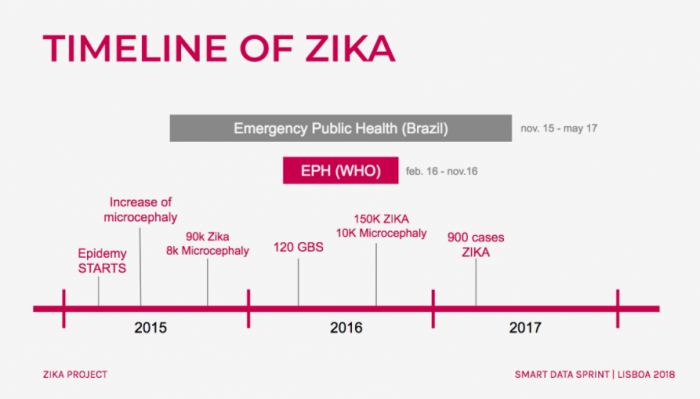
The Zika fever is a relatively “old” disease – the virus was isolated in 1947 in Uganda, and it was the cause of well-documented outbreaks in several Pacific Ocean islands last decade, before appearing with particular virulence in Brazil in 2015, since when the world has been stunned by different and complex consequences provoked by Zika Virus (ZIKV).
In the beginning of 2015 in Brazil, an increase of congenic microcephaly cases occurred during pregnancies in the northeast of the country. Besides, for the first time, health Brazilian authorities identified the ZIKV circulating into the country(1). The association between microcephaly and ZIKV infection has been proved in November 2015 as well as possible other neurological consequences associated with ZIKV, as Guillain-Barrè Syndorme (GSB)(2). On February 2016, almost 6.000 cases of microcephaly newborn babies had been identified in Brazil, most of them in the Northeast. This epidemiological scenario led Brazilian Ministry of Health and World Health Organization to declare Public Health Emergence of National and International Concerns, respectively.
The neurological damage caused by ZIKV is unprecedented in health and medical sciences and threats people all over the world as the ZIKV can be transmitted by the mosquito (Aedes aegypti) and also by sexual intercourse. Other ways of transmission are still under investigation at the moment, as well as the possibility of other species of mosquitoes transmit the virus and the presence of ZIKV in other human fluids.(3) Scientific research shows that microcephaly is a signal of a specific Syndrome named Zika Congenic Syndrome (ZCS). In last two years, other countries identified cases of ZCS but none of them can be comparable with the Brazilian phenomena. (4) Since 2017, cases of ZCS have decreased drastically leading WHO and Brazilian Government to declare the end of Public Health Emergency Situation. However, many questions are still open, characterising it as an uncertain situation for science field, policymakers, and society.
In this context, the impact of ZIKV on the social dimension is enormous. Scientific production, risk communication, repercussions on the health system and social assistance, social and environmental determinants of health, living conditions, sexual and reproductive rights are important issues highlighted by Zika outbreak in Brazil. (5,6)
Addressing it, social media platforms play an important role in the diffusion, discussion and interaction with of scientific knowledge, governmental recommendations, social movements, and society.
- Public Health and Digital Methods
Although epidemiology and public health deal basically with it to conduct population studies, our intention now is dealing with a different kind of data, from a different source and in a different way: non-structured, extracted from social platforms, delivered and linked in multiple media (text, caption, images, video, hashtags, etc.), produced and spread by general people, all this trying to interpret the meanings of these data in terms of engagement. It demands, from the social scientists, new strategies to deal with data; new ways of collecting/crawling, organizing/visualising, understanding/analysing big amounts of raw data. The challenge has been transforming social researchers that are used to deal with small amounts and single-source data on interpreters of big “multi-sourced” data, without giving up the qualitative in-depth analysis of what can be extracted from them to address multifaceted research questions around a phenomenon, like an epidemic.
We aimed, among other goals, to address the role of social media on not only circulate but also produce information (and knowledge) about Zika epidemics for and to the general public, through the popular platforms. In the second, we will investigate how knowledge about the infection, practices of care, and social imaginaries of disease are co-evolving during the first two years of the Zika epidemic in Brazil. From both perspectives, we aimed to construct a “history of the present” of the epidemic, which includes data and its meanings, produced in and spread through social media.
Expectations are that interpreting data in this perspective can be innovative to the public health field, where traditional research and science usually understand data in a stricter sense. Even with all the discussion on big data studies, often it means to work with structures databases from government, health facilities or policy agencies. Only very recently some studies have included social media content as a data to be considered. We, in this project, are understanding them as central to complete the social perspective of Zika epidemic.
We strongly believe that a better understanding of the dynamics of knowledge production, circulation and assimilation with regard to epidemics like Zika amongst the general public can help on the development of improved communication strategies for diffusion of biomedical and public health knowledge.
»Research Questions
How has the general public engaged on the Zika epidemic theme on social media? Would different meanings point to different representations of Zika?
We approached these questions from a broader view (tackling Wikipedia and Google as they are cross-language sources of information) and from a particular view, specifically looking at the discussions on Instagram and on Facebook. From each platform and with different methods, we were looking to address these following questions:
1- Who engages on the theme of Zika? (identification of groups, clusters and networks)
2- How these people engage? (four perspectives of engagement)
3- How does Zika look like to them? (mapping of the imagetic meanings attributed)
4- What are the discourses and perceptions? (qualitative content analysis of image and text)
»Dataset Visual Protocol
Four platforms were chosen to serve as a source of a broader and cross-language view of the discourses about Zika – Wikipedia and Google – and the particular view in Portuguese of the epidemic – Instagram and Facebook.
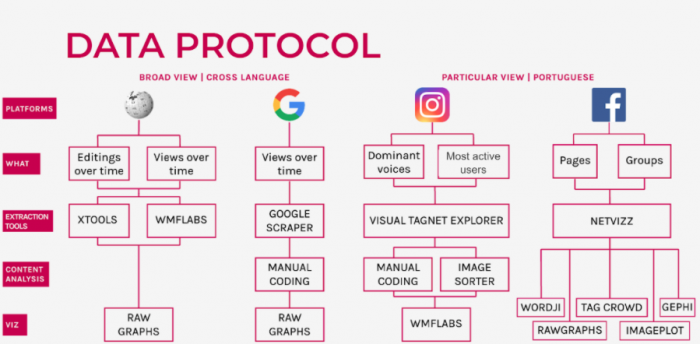
As Wikipedia is frequently in the first page of Google Results for several search queries, we looked for terms regarding to zika in 4 different relevant languages to the epidemic – Portuguese, English, Spanish and French. For each language, we looked for searching and editing patterns over time (from 2015 to 2017).
Regarding to Google, we aimed to explore the most visible results when searching for Zika, the types of websites and how they depict Zika and the references and authorities linked in these websites. Using mostly Google Scraper and Raw Graphs, amongst other tools, to extract data, to code and to depict information about the top ranked pages, their categories and discourse.
With Facebook Pages and Groups, we expected to address how people gather when discussing about Zika. For this, we looked at map of groups per tags (restricted to open groups in Portuguese), using Netvizz, Gephi and Image Plot to extract, analyse and visualise data. We also built a map of the 10 top ranked pages (FanCount+TalkingAbout) pages, also per tags, using Gephi in depth 1 to run a content analysis (co-hashtag or co-term).
Analysing the Instagram posts, we asked: who are the dominant voices engaging on the theme of Zika? How images are being depicted? We based our analysis on the Media Item perspective or “using metrics of audience engagement per media item combined with user activity over time” (Omena et. al, 2017). This perspective is a form of delimiting the dominant and ordinary voices, facilitating the study of the composition and structure of these voices. To delimit the dominant voice of Zika Epidemic debate on Instagram, we generated a dataset for each hashtag using metrics of engagement per media item combined with user activity (or number of publications) over time. For each dataset, we analysed a list with the 10 users who gathered more attention (likes+comments) on their Instagram posts over time. Adding to that, we also analysed the lists of most active users by hashtag mention. We applied manual and automated coding, advanced by tools such as Excel and Image Sorter.
»Methodology
WIKIPEDIA
Focusing on the following key words “zika virus”, “ zika epidemic” and “zika fever”, we looked at Wikipedia articles in order to verify the pages editing over time and the impact of the articles in terms of views.
Summary of Wikipedia Data Collection:
→ Extraction Software: Xtools
→ Visualization and analysis: Raw Graphs and Excel
→ Data extraction based on the following key words: zika virus, zika epidemic, zika fever
→ Languages: English, Spanish, French and Portuguese
→ Time frame of the dataset: October 2009 to October 2018
100 top ranked pages of Google search engine results were extracted using Google Scraper and manually coded by categories through time with Google Spreadsheet.
Summary of Google Data Collection:
→ Extraction Software: Google Scraper
→ Visualization and analysis: Raw Graphs, Adobe Illustrator and Excel.
→ Data extraction based on the top ranked pages regarding ‘zika’ (2015, 2016, 2017)
→ Time frame of the dataset: July 2015 to July 2017 (evolution of the top ranked pages over time)
Summary of Instagram Data Collection:
→ Extraction Software: Visual Tagnet Explorer (by B. Rieder)
→ Visualization and analysis: Gephi, Excel, ImageSorter
→ Data extraction based on a list of hashtags: #abracoamicrocefalia, #aedesaegypti, #chikungunya, #microcefalia, #dengue, #zikavirus
→ Time frame of the dataset: May 2012 to December 2017
→ Significative number of publications on: Dez 2015 and Feb-Mar-Apr 2016 (#aedesaegypti, #chikungunya, #microcefalia; April to Dez 2016, and January to September 2017 (#dengue); and Ago-Sep-Out 2016 and Mai-Jun-Jul 2017 (#abracoamicrocefalia).
→ Most significative year in terms of publications: 2016
→ Total media items: 74.537
→ Total unique users: 38.093
→ Total of most active users by hashtag mention: 39.018*
→ Period of data extraction: July to December 2017
*The amount of most active users is greater than unique users due to Instagram API responses.
#abracoamicrocefalia
media items on Instagram: 1.036 [20 January 2018]
dataset: 752 media items
Total unique users: 118
Total of Most active users by tag mention: 123
Significative number of publications on: Ago-Sep-Out 2016 and Mai-Jun-Jul 2017
Year with more publications: 2017
#aedesaegypti
media items on Instagram: 11.364 [until 20 January 2018]
dataset: 8.183 media items
Total unique users: 4.789
Total of Most active users by tag mention: 5.009
Significative number of publications on: Dez 2015 and Feb-Mar-Apr 2016
Year with more publications: 2016
#chikungunya
media items on Instagram: 31.379 [until 20 January 2018]
dataset: 10.925 media items
Total unique users: 6.156
Total of Most active users by tag mention: 6.407
Significative number of publications on: Dez 2015 and Feb-Mar-Apr 2016
Year with more publications: 2016
#microcefalia
media items on Instagram: 16.049 [until 20 January 2018]
dataset: 11.552 media items
Total unique users: 3.842
Total of Most active users by tag mention: 4.018
Significative number of publications on: Nov-Dez 2015 and Fev-Mar-Apr 2016
Year with more publications: 2016
#dengue
media items on Instagram: 86.844 [until 20 January 2018]
dataset: 22.699 media items
Total unique users: 11.679
Total of Most active users by tag mention: 11.952
Significative number of publications on: April to Dez 2016, and January to September 2017
Year with more publications: 2017
#zikavirus
media items on Instagram: 29,773 [until 20 January 2018]
dataset: 20.426 media items
Total unique users: 11.509
Most active users by tag mention: 12.023
Summary of Facebook Data Collection:
→ Extraction Software: Netvizz v1.44 (search, page data and group data modules)
→ Search Module: Aedes, Zika, Microcefalia, Dengue, ZikaVirus, AedesAegypt, Chikungunya were the key words used to detect pages and groups.
→ Visualization and analysis: Gephi, Raw Graphs, Wordij, and ImagePlot
→ Data extraction based on Facebook Page and Groups IDs
→ Languages: English, Spanish, French and Portuguese
→ Time frame of the dataset: Oct 2009 to Oct 2018
»Mapping Groups and Pages related to Zika on Facebook
Tool: Netvizz v1.44 – Search Module
Queries: Aedes, Zika, Microcefalia, Dengue, ZikaVirus, AedesAegypt, Chikungunya
| Query | Page | Result Number | Group | Result Number |
| Aedes | YES | 487 | YES | 111 |
| Zika | YES | 508 | YES | 159 |
| Microcefalia | YES | 77 | YES | 192 |
| Dengue | YES | 512 | YES | 56 |
| ZikaVirus | YES | 13 | YES | 3 |
| AedesAegypt | YES | 11 | NO | – |
| Chikungunya | YES | 175 | YES | 93 |
»Data Cleaning: Facebook Pages and Groups
Zika related Facebook Pages:
Category : exclude non related categories
Description: exclude non portuguese pages (based on different languages used on description)
Name: exclude non portuguese pages (based on different languages used on description), non related pages (music groups, business etc)
Fans: >10
Dengue and Chikungunya: Eliminate pages that do not include Zika on name or description
Eliminate duplicate pages
Facebook Pages | Total count: 229
Zika related Facebook Groups:
Description: exclude non portuguese pages (based on different languages used on description)
Name: exclude non portuguese pages (based on different languages used on description), non related pages
Dengue and Chikungunya: Eliminate pages that do not include Zika on name or description
Exclusion of pages with last activity before July 2016
Facebook Groups | Total count (open and close) : 111
[64 open groups]
| Query | Page | Result Number | Group | Result Number |
| Aedes | YES | 154 | YES | 65 |
| Zika | YES | 7 | YES | 8 |
| Microcefalia | YES | 49 | YES | 25 |
| Dengue | YES | 2 | YES | 2 |
| ZikaVirus | YES | 1 | YES | 2 |
| AedesAegypt | YES | 5 | NO | – |
| Chikungunya | YES | 11 | YES | 9 |
»Facebook selected Pages and Groups
PAGES:
| Microcefalia | Personal Blog | 83 | 17 |
| Repelente contra mosquitos que transmiten Zika, Dengue, Chikungunya May-Ki | Health/Beauty | 33 | 18 |
| Microcefalia Myllena Suzart | Government Official | 191 | 27 |
| Microcefalia Princesa Ágatha | Personal Blog | 203 | 42 |
| Aedes Aegypti, Vamos Combater. | Community | 49 | 64 |
| Alcobaça no Combate ao Mosquito Aedes Aegypti | Community | 40 | 91 |
| Luis Miguel vencendo a Microcefalia com amor | Community | 187 | 126 |
| Comitê Municipal De Combate Ao Aedes Aegypti – Cedro/ce | Community Service | 186 | 158 |
| Proteção contra Dengue Zika Chikungunya | Health/Beauty | 11 | 492 |
| Aedes do Bem | Community | 3483 | 5049 |
Top 10 pages according to talking about metrics*
| Name | Category | Fans | Talking about |
| Combate Aedes Aegypti | Other | 2882 | 2 |
| Aedes Aegypti | Fictional Character | 2946 | 0 |
| Microcefalia Sim | Community | 3021 | 2 |
| Radar Aedes | Community | 3259 | 1 |
| Aedes do Bem | Community | 3483 | 5049 |
| Zika Vírus | Community | 4108 | 2 |
| Gravidez em tempos de Zika | Community | 7326 | 3 |
| Congresso Nacional de Microcefalia | Medical Company | 10900 | 8 |
| Crianças Contra Zika | Community | 32915 | 9 |
| Dezinho Contra o Aedes | Community | 36806 | 16 |
Top 10 pages according to number of fans*
*[only one page was in both ranks]
GROUPS:
| Page ID | Name | Icon |
| 322673928108989 | Virus | https://static.xx.fbcdn.net/rsrc.php/v3/yf/r/mqifb05bVG8.png |
| 458512897671569 | microcefalia especial é ser especial | https://static.xx.fbcdn.net/rsrc.php/v3/yF/r/MzwrKZOhtIS.png |
| 531533843673323 | Combate ao mosquito Aedes Aegypti | https://static.xx.fbcdn.net/rsrc.php/v3/yP/r/GkLsVCCrHg4.png |
| 1111651335513746 | DENGUE ,ZIKA E CHIKUNGUNYA TÔ FORA… | https://static.xx.fbcdn.net/rsrc.php/v3/y4/r/7-WQmfPF17n.png |
| 424197964418355 | TURMA – ” M ” COMBATE AO AEDES AEGYPTI. | https://static.xx.fbcdn.net/rsrc.php/v3/yT/r/YICBjPeHOsa.png |
| 1550362531945516 | Combatendo o Aedes Aegypti, Patos-PB | https://static.xx.fbcdn.net/rsrc.php/v3/y4/r/7-WQmfPF17n.png |
| 1693694640868851 | Desafio do Aedes: Vamos eliminar esse mosquito! | https://static.xx.fbcdn.net/rsrc.php/v3/yn/r/BW2s6xRjIQf.png |
| 953840204695128 | Aroeiras unida, jamais será vencida. Todos juntos contra o Aedes Aegypti | https://static.xx.fbcdn.net/rsrc.php/v3/yF/r/MzwrKZOhtIS.png |
| 585221381506098 | Penápolis no combate ao mosquito Aedes Aegypti | https://static.xx.fbcdn.net/rsrc.php/v3/yF/r/MzwrKZOhtIS.png |
| 488467228014145 | Comissão de Combate ao Aedes aegypti – Ceunes/UFES | https://static.xx.fbcdn.net/rsrc.php/v3/yd/r/NbS-bURYjlm.png |
| 1684038231844629 | Pais com crianças com microcefalia e outras deficiências | https://static.xx.fbcdn.net/rsrc.php/v3/yF/r/MzwrKZOhtIS.png |
| 1563521380638348 | Microcefalia e paralisia cerebral/Luiz Henrique | https://static.xx.fbcdn.net/rsrc.php/v3/yF/r/MzwrKZOhtIS.png |
| 773047542775158 | Butantã sem Aedes!!!!! | https://static.xx.fbcdn.net/rsrc.php/v3/yb/r/HSAHaJd0l6J.png |
| 1908257762765789 | MICROCEFALIA ( A EVOLUÇÃO DESSAS CRIANÇAS)QUE POSSAMOS POSTAR A EVOLUÇÃO | https://static.xx.fbcdn.net/rsrc.php/v3/yF/r/MzwrKZOhtIS.png |
| 929325990455010 | Mosquito Aedes aegypti é o transmissor de três doenças … | https://static.xx.fbcdn.net/rsrc.php/v3/yG/r/B-jBsv2KV1g.png |
| 472620789615242 | TODOS CONTRA O AEDES AEGYPTI EM IPIXUNA DO PARÁ | https://static.xx.fbcdn.net/rsrc.php/v3/yF/r/MzwrKZOhtIS.png |
| 702190103243207 | Amigos do Aedes aegypti. | https://static.xx.fbcdn.net/rsrc.php/v3/yq/r/zFDa8yqE6U1.png |
| 1656306004633636 | Aedes egypti, aqui não… | https://static.xx.fbcdn.net/rsrc.php/v3/yG/r/B-jBsv2KV1g.png |
Periods of activity time: 2016, 2017, 2018
Number of groups: 5 groups per period – selection on top 5 based on number of members
Extracting group data: last 100 posts + stats (network and comment files) + Gephi
»Findings
»Wikipedia: Zika edits and views overtime
The first step was to check the editings over time, aiming to see when the topic Zika started to be discussed in this platform, and consequently, the frequency of editing in each language (Portuguese, English, Spanish and French). Results show that pages in Portuguese are new when compared to other languages (see the chart below, and check April 2015). The pages in English had more editing, but it can be due to the volume of access and use of wikipedia in this language.
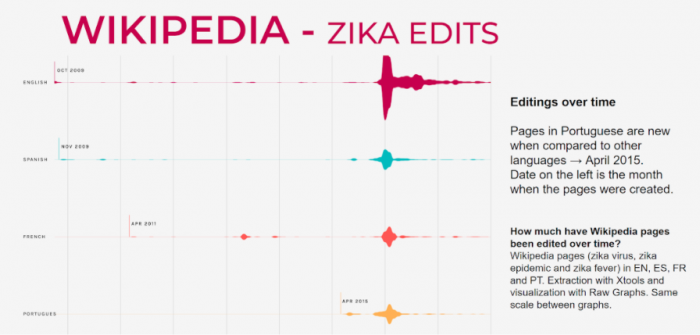 To balance the weight of the language access bias, we looked for the views over time to each page. We can see, above and below, that the period of the most views is quite the same, although the proportional scale (see squares below) shows that, amongst Portuguese speakers, Wikipedia was not an meaningful source as it was to other languages, for instance English.
To balance the weight of the language access bias, we looked for the views over time to each page. We can see, above and below, that the period of the most views is quite the same, although the proportional scale (see squares below) shows that, amongst Portuguese speakers, Wikipedia was not an meaningful source as it was to other languages, for instance English.
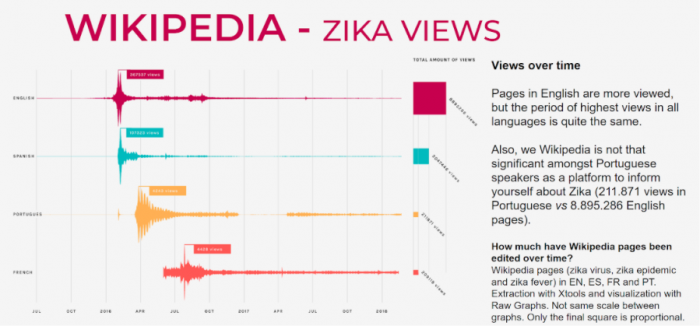
»Google: Top ranked websites, key players and associated content
From the top ranked websites scraped, we proceeded to a coding of the information source, coming up with 9 categories that represents the “actors” and their discourses about Zika.
The graph below shows that, in all the years, Media & Press top ranked the Google searches, which definitely shows the power of the media as an information source to the general public. However, we noticed that between 2015 and 2017 the number of Government pages increased from 14 to 22 on the rank . Meanwhile, Media & Press decreased from 41 to 35. This change can indicate that official channels (or more accurate interpretations about Zika Epidemic) are gaining more relevance in the representation of Zika virus.
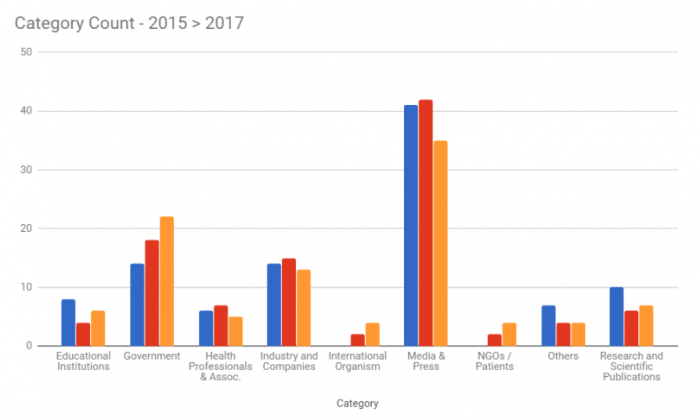
We can also see that most of the top ranked websites in 2015 are not present in the 2017 ranking. The majority of the pages ranked in 2015 were content explaining “What is Zika” due the outbreak, because the Brazilians were not aware of the disease.
Looking deeper into gathered data (all the 3 years), between the 233 ranked pages, 42 instances were from Industry and Companies (18%). We also saw that the best ranked company website in 2017 is a product page about the book “Zika: do Sertão Nordestino à Ameaça Global” (Zika: From the Northeast countryside to Global Threaten) from Débora Diniz, in the 20st position. This scenario has caught up our attention, and consequently, we proceeded to a sub categorisation of Industry and Companies top ranked pages as it follows:
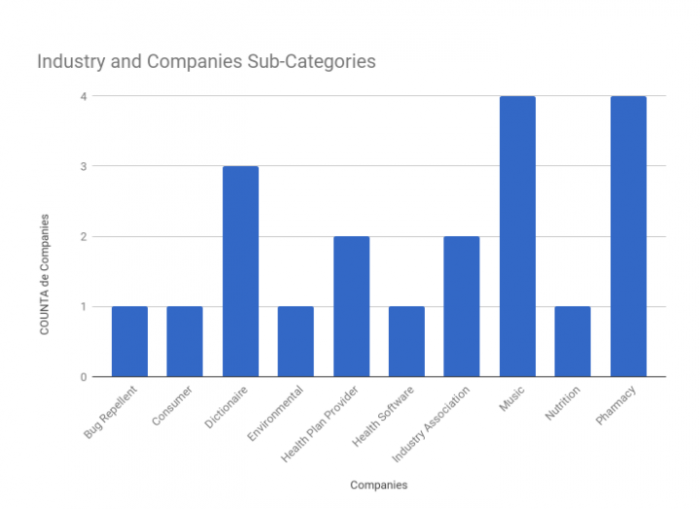
Private Hospitals and Clinics were responsible for 13 ranked pages, followed by Private Laboratories (7 pages) and Pharmacy companies (4 pages). In the “Private Hospitals and Clinics” sub-category, the top ranked page is entitled “13 cuidados para evitar contrair zika vírus na gravidez” (13 steps to avoid Zika Virus in pregnancy time)(48th position) in the CordVida website. CordVida is a clinic specialized in stem cells storage.
Most of the industry and companies websites offer services, with the exception of two product websites in 2015. The first one, a website about nutrition supplements (“Suplementos Brasil”) published a simple article on “Zika: saiba tudo sobre o novo vírus” (Zika: Know everything about the new virus). The other one is an informative webpage on the insecticide Raid website. The page has information on how to combat and avoid dengue and zika mosquitoes.
Other interesting result is the difference between years: from 2015 to 2016 the Google Rank change completely, only 8 sites out of 100 appear in the ranking of 2016. Whereas we can find 60 links from the rank of 2016 that remains on the rank of 2017.
When we look deeper into the information about “Zika” in Google.br, though the evolution of the top 100 pages of Google ranking from 2015 to 2017 (see below), we see the <g1.globo.com> was the most stable over the years, and it belongs to the strongest media/press group in Brazil. The second and third most stable websites are educational ones. <brasil.babycenter.com> is a website about pregnancy. The following websites on the rank position represents the press/media, govern and professional association categories, respectively.
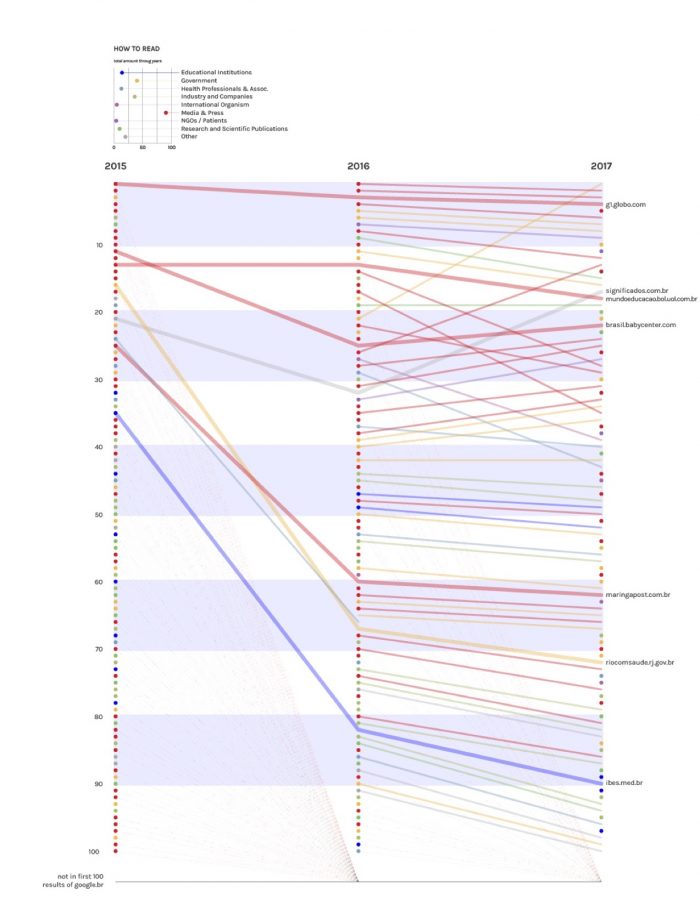
The distribution over time (from 2015 to 2017) of the broken down categories can be seen below:
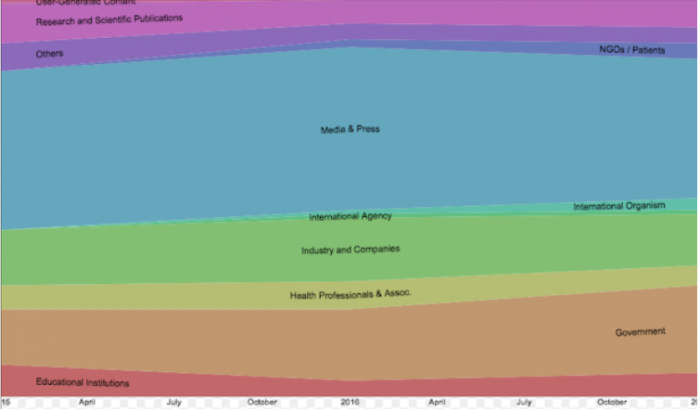
»Instagram: The dominant voice and the most active users by tag mention
The main questions that guided our work on Instagram Platform were: who are the dominant voices engaging on the theme of Zika? How images are being depicted?
We first analysed the dominant voice and the lists of most active users by tag mention that emerged from seven hashtags closely related to Zika Epidemic: #zika, #zikavirus, #aedesaegypt, #dengue, #chinkunguya, #microcefalia, and #abracoamicrocefalia summing up 74.537 media items and 38.093 unique users.
After the analyses, we detected four predominant groups:
-
- Children and parents of microcephalic kids
-
- Industry and companies (selling “solutions” and “preventions”)
-
- National and International Press (especially Newspapers from the Northeast of Brazil)
- Botted accounts
These groups can be considered both influential and dominant voices on what concerns the Zika Epidemic debate on Instagram.
We also detected the periods with significative number of publications: Dez 2015 and Feb-Mar-Apr 2016 (#aedesaegypti, #chikungunya, #microcefalia; April to Dez 2016, and January to September 2017 (#dengue)
Through the tags #abracomicrocefalia and #microcefalia we found Instagram profiles depicting microcephalic kids and administered by their parents. It is interesting to note that #abracomicrocefalia (I embrace the microcephaly) is the name of an NGO located in the city of Salvador, state of Bahia, Brazil. As a consequence, most of the microcephalic kids profiles originated from this tag represent families from Salvador. However, the tag #microcefalia do not restrict the profiles to a specific location, on the contrary, we identified that the microcephalic kids profiles actually represent different regions of Brazil.
Generally, most of the profiles (both originated from #abracomicrocefalia and #microcefalia) show infants under the 24 months of age, who were probably infected by the Zika Virus resulting in microcephaly. We detected an important tag connected with this groups, which is #microcelafianaoeofim (microcephaly is not the end). The imagery of this group displays the everyday life of microcephalic kids and, in general, the visual narrative suggests action in opposition to passivity (which could be a expected reality to families in such conditions). For instance, physiotherapy sessions and others therapies, the everyday life with family and other baby friends with microcephaly, the growth of these children.

Visual representation of the dominant voice: Childhood and parents of microcephalic kids.Another interesting point, and observed through the visual content analysis, is to perceive the standard of living; most of these families (that represent the dominant voice) belongs to lower middle classes. In their profile description, crowdfunding sites and others forms of assistance or financial help are very common characteristics of this group.
The tags #dengue, #chinkunguya, #aedesaegypt disclose different dominant voice profiles: the industry and companies selling “solutions” to avoid mosquitos – for instance repellents, mosquito net, among others technological solutions and applications (i.e. protec_microbac, mosquitnoamericas, blockinsetos, clickdengue; press and daily newspapers, especially from the Northeast of Brazil – namely Diário de Pernambuco (e.i. 1, 2, 3, 4, 5, 6). The profiles of industry and companies prevails/predominate in the most active users by hashtag mention; depicting the overwhelming majority of Instagram accounts that most mention hashtags related to Zika Epidemic. Whereas through the tags #zika and #zikavirus, we detected that the NGO profile abraçoamicrocefalia (I embrace the microcephaly) as dominant voice, as well as international media channels and actors such as Discovery Channel (e.i 1, 2), World Press Photo (e.i. 1, 2), and Unicef (e.i. 1, 2, 3, 4, 5, 6). Beyond the official account unicef, the United Nations Children’s Fund is also represented by official profiles from different countries and initiatives: Brazil (unicefbrasil); El Salvador (unicefsv); Guatemala (unicefguatemala); USA (unicefusa); Jamaica (unicefjamaica); Spain (unicef_es); Sweden (unicefsverige); BenU Unicef (benu.unicef); and, Unicef Innovation (unicefinnovate).
An important point to be detached is the absence of Brazilian public/government entities within the group of dominant voice; with the exception of São João do Meriti city hall (in Rio de Janeiro). Considering the dominant voice’s logic of engagement (the ability to attract considerable attention over time with publications on Instagram) and the chosen hashtags, no other Brazilian public entity was capable to produce influential visual content about Zika Epidemic in Brazil.
The composition of the dominant voice is also constituted by botted accounts, for instance thememesfarmer and hugo.milgrau. Driven by this discovery, we explored the ordinary voice (those actors who not belong to the dominant voice list) in order to detect the agency of botted accounts, for instance through verifying the accounts name and their creation time or comparing the number of publications with the total of followers or following or checking the followers of the bots profiles (because bots like and follow other bots) (Omena, 2017) [7]. Due to time constraints, we opted for verifying the accounts name, and it did not take long to identify botted accounts that adopted the tags such as #zika, #zikavirus, and #dengue (see below) . The agency of automated being should be taken into consideration; further analysis should be done in this regard.
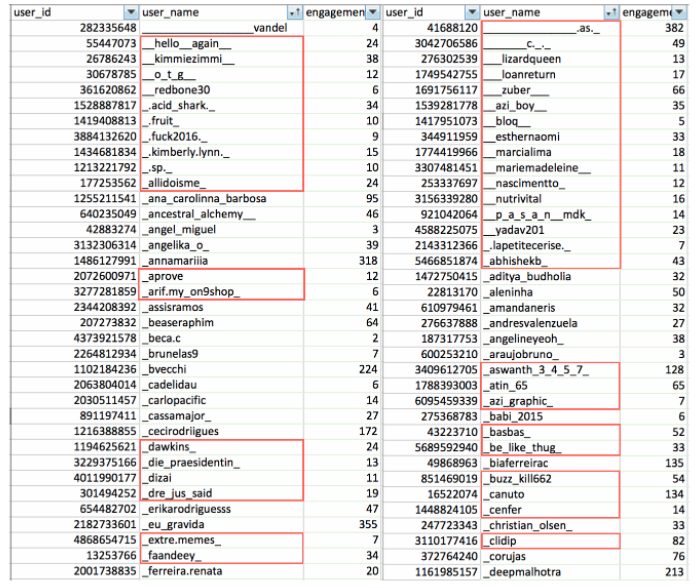
In the second step, we scrutinized the visual content generated by #zikavirus, a total of 6.644 images. The analytical process was based on colour pattern with visualization advanced by ImageSorter (see below). The visual narrative is mainly displayed by informative posters and banners about Zika Epidemic and its symptoms. The mosquito itself is naturally an object of discussion, just as correlations between the mosquito and pregnancy or a particular sport event – namely the 2016 Olympic Games in Rio de Janeiro.
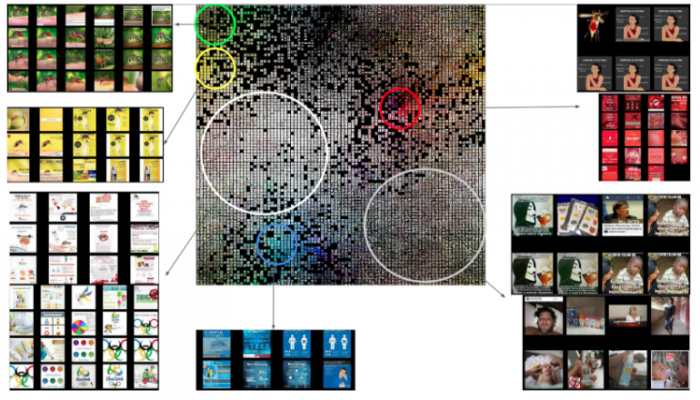
[6.644 images. Tools: Visual Tagnet Explorer + DownThemAll + Image Sorter]
»Facebook: Network, Visual and Textual Analysis of Pages and Groups related to Zika
»Facebook Pages
- Zika: Network Analysis of Facebook Page Like Network
The main question regarding Facebook Page Like Network: Do the pages connect to each other?
We performed network analysis with the selected Pages (previously mentioned on the methodology section). We could see (see the graph below) that the pages barely forms a network, except those that serve as a sort of diary for microcephaly babies’ families or for the vector combat agents.
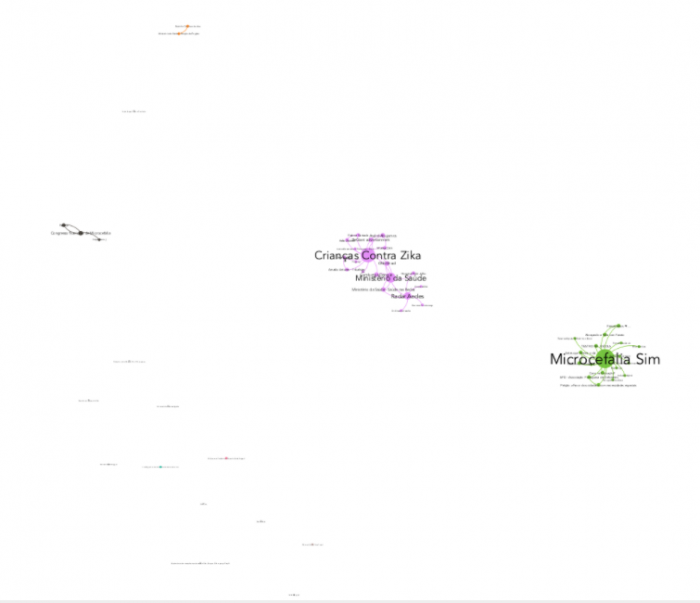
Gephi visualization led to the perception that the selected pages are not connected. Analyzing the pages names and description, one hypothesis is that these are been used in a more personal level, close to a daily journal, either from agents combating the mosquito and the diseases related with (zika, dengue, chikungunya) and from people affected by the Zika (especifically babies born with microcephaly). A third type of page appeared as well, which aims to sell repellent also appeared in this analysis, and these also do not connect with other pages.
- Page Content Analysis
From the network analysis, we decided to select only the 15 most active pages, and with more fans (metrics: talking about and number of fans). Adding to that, we filtered page content analysis according to period of time: from 1 Jun 2016 to 31 Jan 2018. After that, we thus analyzed the engagement per type of content, using Raw Graphs.
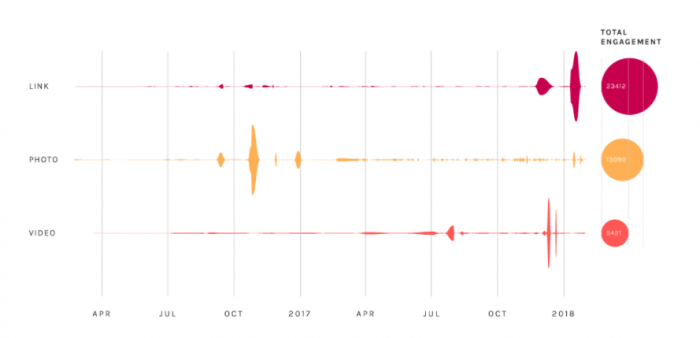
The visualization above guided the visual and textual content analysis, meaning that posts were selected according to periods of peaks of engagement.
How Facebook Pages depict Zika?
Two main kinds of images were shared by Facebook Pages between June 2016 and January 2018: toddlers with microcephaly and banners/infographics regarding prevention and combat to the mosquito (see below).
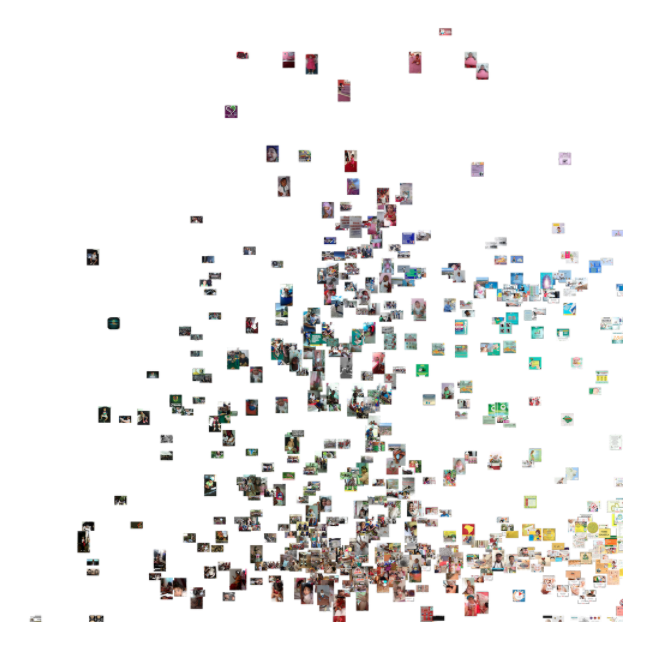
Visual content of 15 Facebook Pages selected via talking about and number of fans.
Images filtered by period of time – from 1 Jun 2016 to 31 Jan 2018, and gathered by similarity.
Images Analyzed: 652. Plot by Median Hue (X) x Engagement (Y)
Data Extraction tool: Netvizz. Analysis Software: ImagePlot.
Both categories (toddlers with microcephaly and banners/infographics) are heavily present across the entire timeline. Analysing the engagement rate on the content, we could see a high peak on the private company page, interested in combating the Aedes Aegypti mosquito.
- Textual Content Analysis: posts of Facebook Pages
We also ran a textual content analysis of 875 posts of the selected pages. The main theme is the combat of the mosquito. One explanation may be the sponsoring of private companies selling technology for prevention.
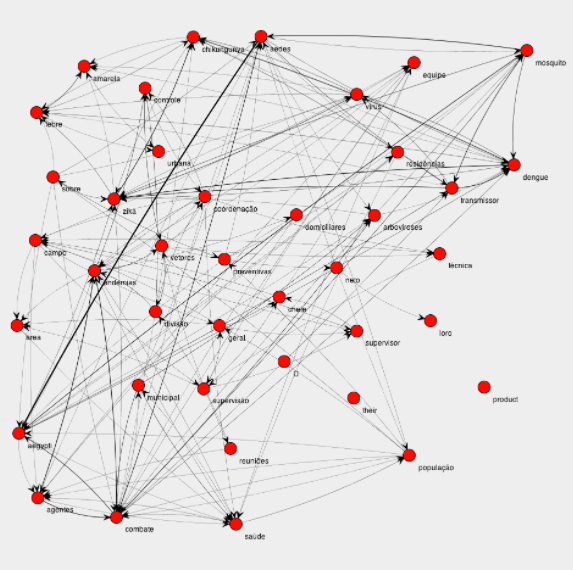
Data extraction: 31 Jan 2018. Data Extraction tool: Netvizz. Analysis Software: Wordij.
After eliminating the private companies associated content (e.g. sponsored content of private biotech company), we generated a Cloud of content which reveals a secondary theme: microcephaly (see below).
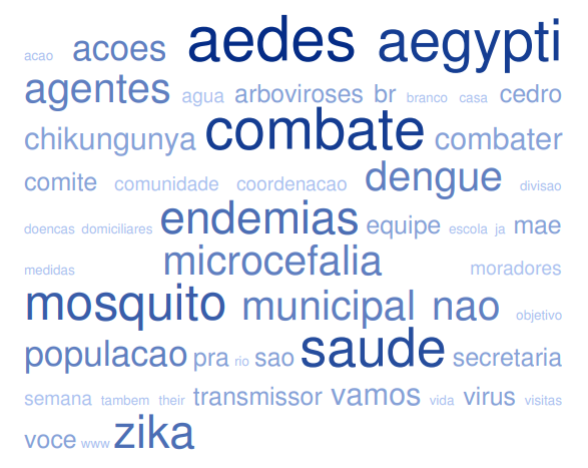
We may state that the main topics of discussion on Facebook Pages vary and with it depends on the inclusion or exclusion of private company posts.
»Facebook Groups
- Visualising the reactions of Facebook Group Members via User-Post Bipartite Graph
Aiming to visualise the reactions of Facebook Group Member, we generated the user-post bipartite graph (which by the way, is no longer an option via calling Facebook graph API). In the graph below, nodes are users (gray) and posts (pink). Connections are made when users interact with posts, for instance by liking or commenting. There is a significant number of posts that do not generate any reaction from the members of the groups (see below). The ring that surrounds the main component shows that there is a lack of interaction amongst users and the publications of the Groups. In other words, what we see is a large number of publications that cannot provoke reactions.
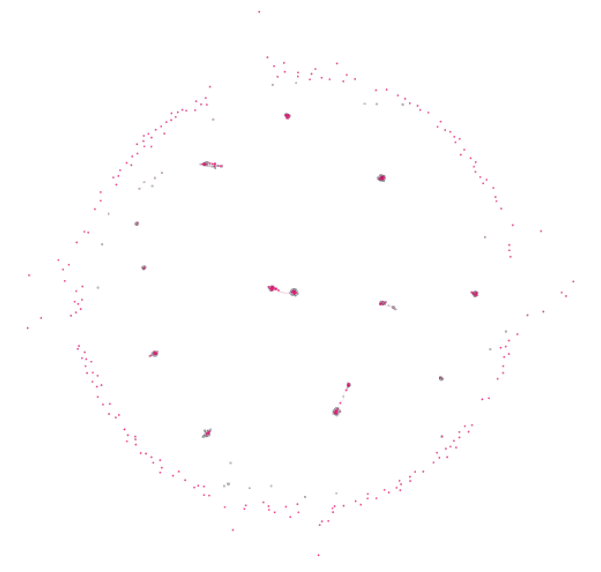
- Facebook Groups: the role of post type
Regarding the ways of engaging on these groups, the post type photo is considerable more relevant, followed by videos. Less attention is paid to posts type links or status (see below).
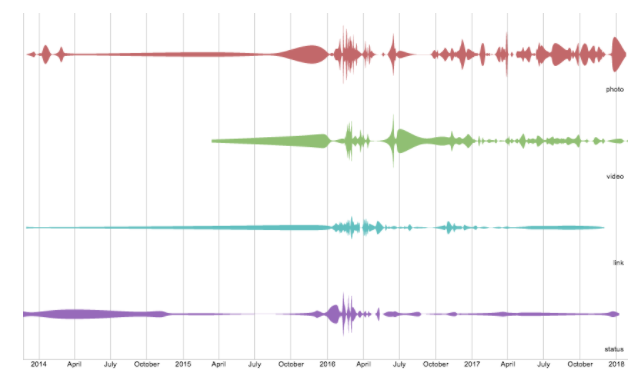
Regarding the period of April 2016- October 2016 in which there was a peak of engagement in videos, we verified the these latter were shared by ‘school’ groups (e.g. Projeto do Colégio DOM PEDRO II Todos contra o Aedes aegypti). The top 10 videos that had more engagement are also included in the category “prevention and care”.
After the production of the chart above, we input the data for the period of January to April 2016 on Image Plot in order to explore the visual content produced by Facebook Groups, and related to Zika Epidemic.
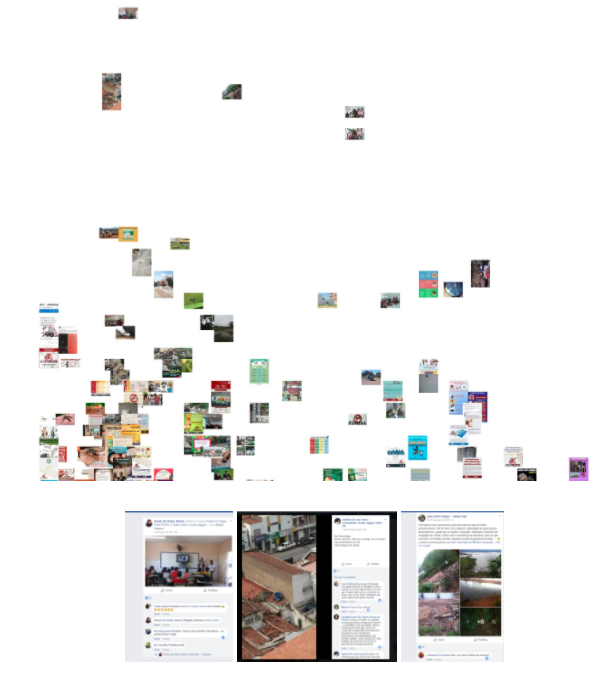
The images at the top of the engagement rank seems to be related to local campaigns in schools. We can include them in the categories of ‘Prevention and Care’. The majority of the photos present a low engagement, as we previously mentioned before with the Groups network analysis.
We selected three post with high engagement:
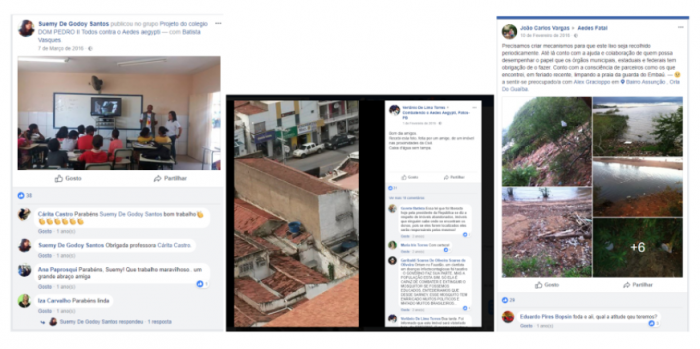
»Conclusion
Overall, this project aimed to address the role of social media in the circulation and production of information and knowledge about Zika epidemics for and to the general public in Brazil. Additionally, we also could investigate how knowledge about the infection, practices of care, and social imaginaries of disease co-evolved during the first two years of the Zika epidemic in Brazil. From both perspectives, broader and particular, we aimed to construct a “history of the present” of the epidemic, which includes data and its meanings, produced in and spread through social media.
From all the content analysis of the dataset we had, four themes appeared as the core of the meanings attributed to zika: the infection itself and the vector; care and prevention practices, different actors with different perspectives and ways of engagement; and the impacts and consequences of the infection, mainly the microcephaly. These themes appeared in different ways, according to the specificities of each platform, from what we could see that:
—>As a source if information about Zika, Wikipedia is not as relevant to Portuguese speakers as it is to English speakers.
—> On Google, media and press websites are the most accessed as a source of information about Zika, although govern websites increased of importance during the last years. Industry and commerce have also been important voices on this platform.
—> On Instagram, there is an absence of Brazilian government entities within the group of dominant voice; in general, they were not capable of producing influential visual content about Zika epidemic in Brazil.
—> On Facebook, besides the long list of Pages and Groups associated with Zika Epidemic, there is an absence of a Page Like Network community . The visual content analysis points to two kinds of images being shared by Facebook Pages between June 2016 and January 2018: toddlers with microcephaly and banners/infographics regarding prevention and combat to the mosquito. The main topic of discussion in the groups refers to “prevention and care” about Zika Epidemic, and Schools play a key role in sharing videos related to this topic (produced by students and teachers).
Also, it is important to pinpoint what was not a theme, according to our dataset, showing important issues that are not being debated online: the sexual transmission of Zika Virus, the role of the absent of Social and Environment Determinants of Health to the spread of Zika and the connections between the Zika and the debates on sexual and reproductive rights in Brazil
Overall, expectations are that data discussed during the sprint can somehow contribute to innovative perspectives on the public health field, and also help to the understanding of digital methods as central to complete the social perspective of Zika epidemic.
»References
[1]Barreto ML, Barral-Netto M, Stabeli R, Almeida-Filho N, Vasconcelos PF, Teixeira M, Buss P, Gadelha PE. Zika virus and microcephaly in Brazil: a scientific agenda. Lancet. 2016;387:919–921.
[2] Emily Erbelding, Cristina Cassetti; Zika Virus and Future Research Directions, The Journal of Infectious Diseases, Volume 216, Issue suppl_10, 16 December 2017, Pages S991–S994, https://doi.org/10.1093/infdis/jix492
[3] Calvet et al. Study on the persistence of Zika virus (ZIKV) in body fluids of patients with ZIKV infection in Brazil. BMC Infectious Diseases (2018) 18:49
[4] WHO. Zika Countries Classification scheme. (2017) http://www.who.int/csr/resources/publications/zika/classification/en/
[5] Possas C. Zika: what we do and do not know based on the experiences of Brazil. Epidemiology and Health. 2016;38:e2016023. doi:10.4178/epih.e2016023.
[6] Rasanathan et al. (2017). Engaging Human Rights in the Response to the Evolving Zika Virus Epidemic. American journal of public health. 107. e1-e7. 10.2105/AJPH.2017.303658.
[7] Omena, J.J. (2017). Insta Bots and The Black Market of Social Media Engagement. The Social Platforms [Research Blog] https://thesocialplatforms.wordpress.com/2017/12/21/insta-bots-and-the-black-market-of-social-media-engagement/
